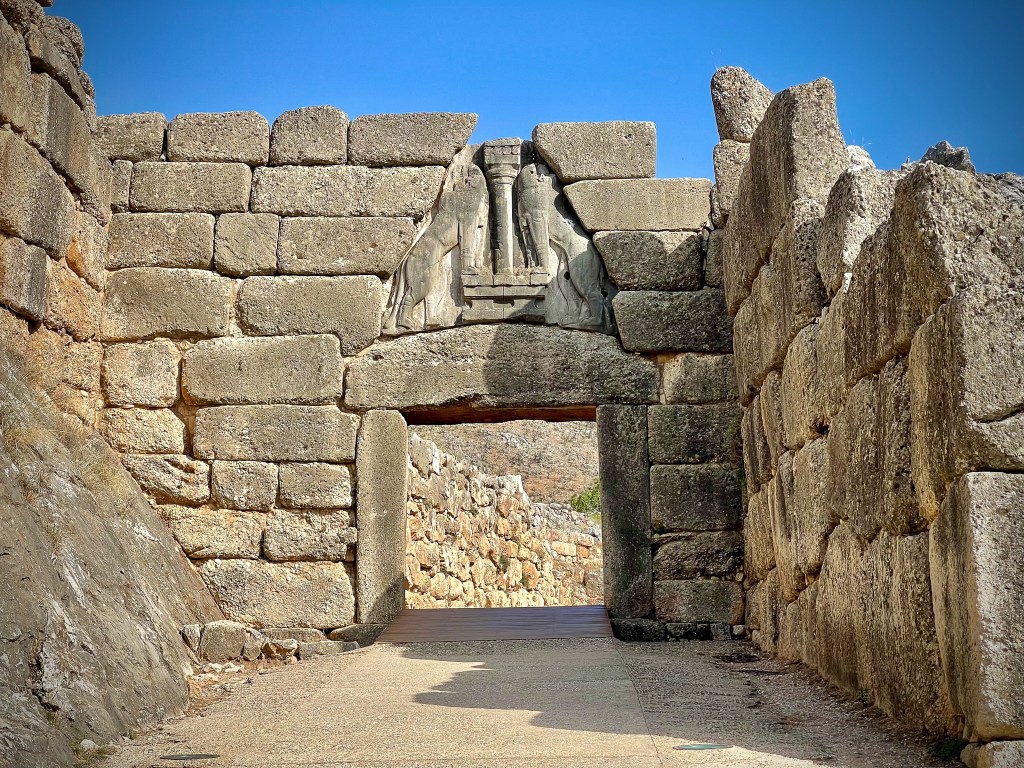
I probably never mentioned that I have lived in Greece as a boy for three years. That said, I have grown up with the ancient sagas telling the stories and adventures of the heroes of Greek mythology. One of the greatest was Agamemnon, the king of Mycenae and victor of the Trojan war. “Greece explored – Mycenae” takes you on a trip through his legendary castle on Argolian hills of the Peloponnese.
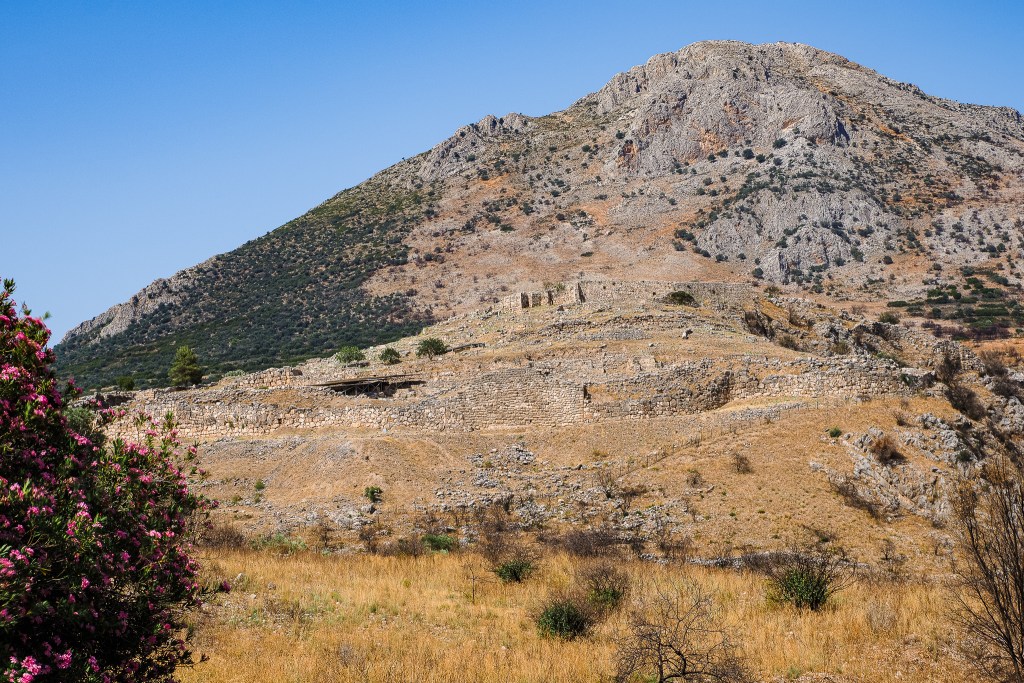
The Acropolis of Mycaene is only a good 30 minutes drive from our Holiday Happy Place, so it was one of our prime sightseeing destinations of our summer vacation on the Peloponnese.
Mycenae was one of the most important centers of Greek civilization and a military fortress that dominated much of southern Greece. It was a military state that rose to power after the collapse of the Minoan civilization. The Mycenaeans dominated trade and shaped ancient Greece between 1600 and 1100 BC, which is why this period of Greek history is called the Mycenaean period. Agamemnon and Menelaus, Danaë and Perseus, Pelops and Atreus are the apparent ancestors of all Europe, and the birthplace of all these historical figures is golden Mycenae.
The peak of the Mycenaeans, with their majestic architecture, inscribed monuments and sophisticated civilization, was in the Late Bronze Age between 1350 and 1200 BC. Palace complexes, the famous tomb of Agamemnon, also known as the Treasury of Atreus, huge arches, fountains and city walls form one of the largest architectural complexes of the ancient world. The decline of the Mycenaeans occurred around 1100 BC, possibly due to repeated damage from earthquakes and fires. However, during their reign they created an empire that has undoubtedly imprinted its mark not only on the history of Greece, but on the whole world.

Approaching the archeologic site (Unesco World Heritage site since 1999), the first monument a few hundred meters below the castle hill is the Treasury of Atreus (a.k.a. Tomb of Agamemnon). It is a large tholos or beehive tomb constructed during the Bronze Age around 1250 BC. The stone lintel above the doorway weighs 120 tons, with its approximate dimensions 8.3 x 5.2 x 1.2m the largest in the world. The tomb was used for an unknown period. Mentioned by the Roman geographer Pausanias in the 2nd century AD, it was still visible in 1879 when the German archaeologist Heinrich Schliemann discovered the shaft graves under the “agora” in the Acropolis at Mycenae.
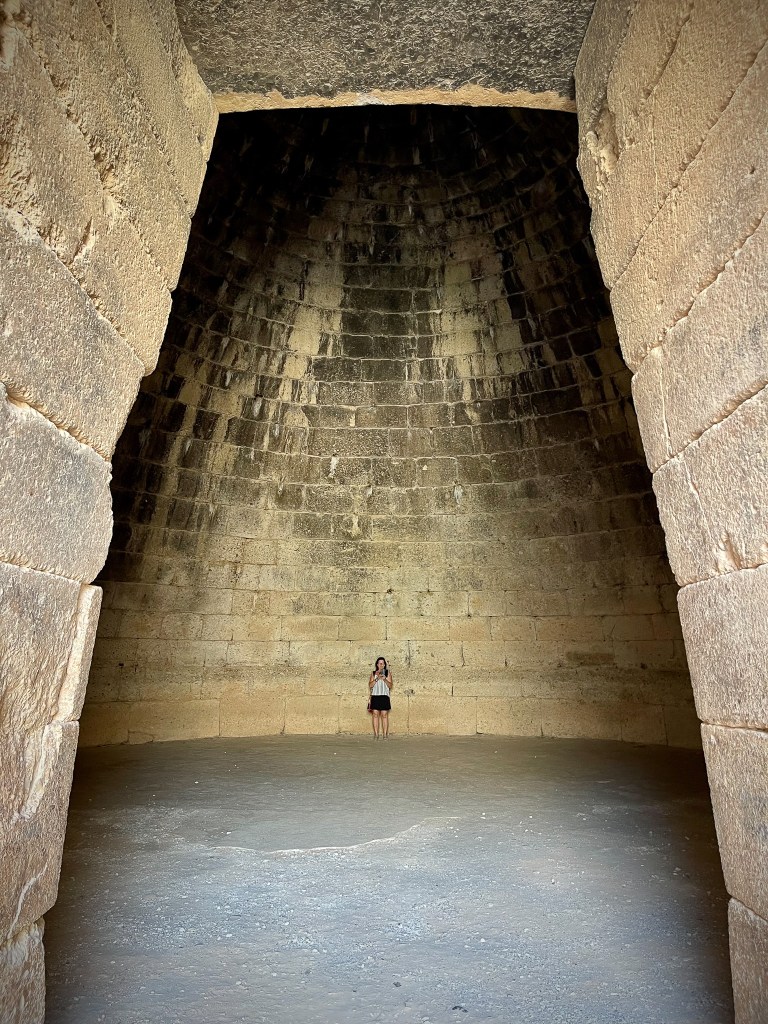
The tomb has probably no relationship with either Atreus or Agamemnon – legendary rulers of Mycenae or Argos in the works of Homer. Archaeologists believe that the Mycenaean sovereign buried there ruled at an earlier date as king. It was named by Heinrich Schliemann, German archeologist and principal discoverer of Mycenae, and the name has been used ever since. The tomb is excavated into the side of a hill. With an interior height of 13.5m and a diameter of 14.5m, it was the tallest and widest dome in the world for over a thousand years until construction of the Temple of Mercury in Baiae and the Pantheon in Rome.
The room was constructed by digging vertically into the hillside, like a well, and then walling and roofing the space with stone from the floor level of the chamber, and finally back-filling the earth above. Great care was taken in the positioning of the enormous stones, to ensure the vault’s stability in bearing the force of compression from its own weight. This gave a perfectly smoothed internal surface, onto which could be placed gold, silver and bronze decoration. When Schliemann discovered the tomb, it was already robbed of its treasures.

Upon arriving at the gates of the castle, The Significant Other and I started with a tour of the (climatized) Museum to avoid the worst of the afternoon heat (36 Celsius). On display are the many artifacts found while excavating the ancient city and the many graves around the hill.
During excavations near the “Lion’s Gate” of Mycenae, Schliemann came across a tomb that contained three unusually large skeletons, one of which had apparently been robbed. The other two wore gold masks and additionally a golden breastplate. Because of the special gold mask and the size of the skeleton which was the southernmost in the tomb, and the other rich furnishings, Schliemann assumed that it must be Agamemnon.

Schliemann thought that all the gold finds from the tombs were much too thin to be worn by living rulers or warriors. The jewelry had been made especially for the burial of the kings.
According to today’s knowledge, the tomb and the contained finds are dated to the middle of the 16th century B.C. and can therefore hardly be assigned to the Atrides and King Agamemnon. In general, it is assumed that the legends about the Trojan War and thus also the mythical figure of Agamemnon reflect a significantly later time than the 16th century B.C.. Therefore, today it is assumed that the mask belonged to the tomb of a Mycenaean prince of a previous dynasty.

The museum displays also many other burial objects discovered in the many graves around the ancient city.
After finishing the tour of the museum, we spent the last two hours of our visit exploring the ancient fortress with the Kings’s Palace on top, benefiting from the softening evening light in the ruins.
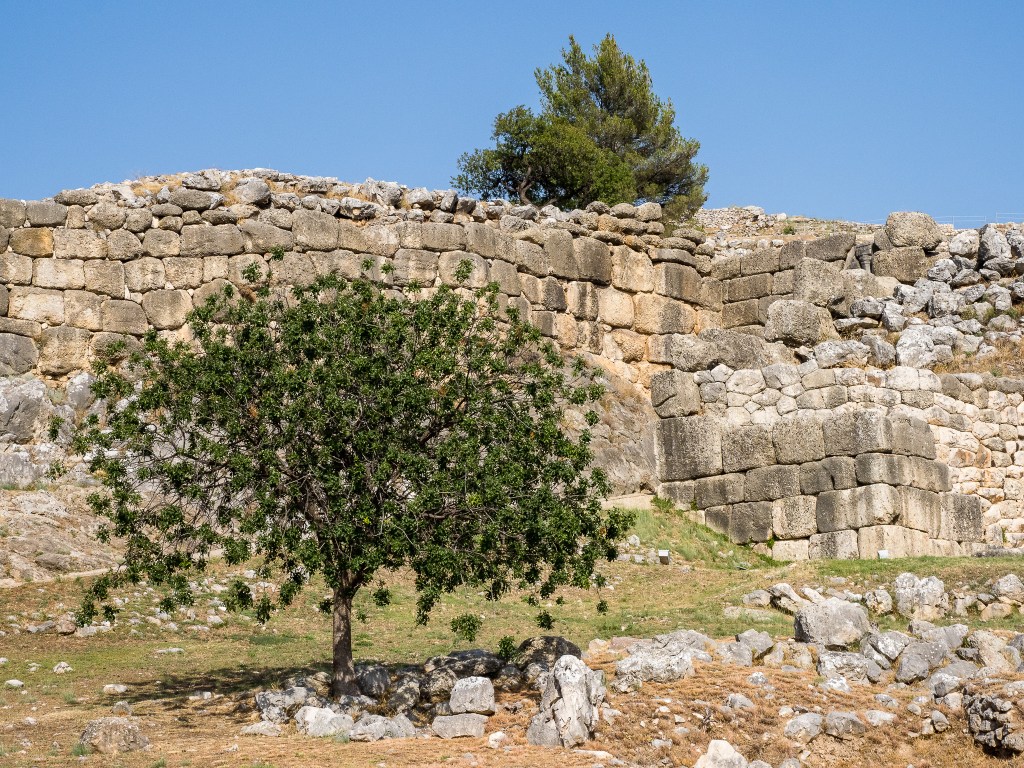
Super impressive are the Cyclopean castle walls, built some 3500 years ago. According to the legends, the Cyclops – one eyed giants of the Greek mythology – helped building these walls. This stonework is typical for Mycenaean architecture, built with massive limestone boulders, roughly fitted together with minimal clearance between adjacent stones and with clay mortar or no use of mortar at all. The boulders typically seem unworked, but some may have been worked roughly with a hammer and the gaps between boulders filled in with smaller chunks of limestone. Although the size of the individual stones is mind-blowing. And how the ancient workers (or their slaves) have moved them to build those walls. On Wikipedia I found the following facts on building the ancient castle :
Wall circuit length: 1,105 metres (3,625 ft)
Preserved height: up to 12.5 metres (41 ft)
Width: 7.5-17 meters(!!!)
Minimum stone required: 145,215 cubic metres or 14,420 average stones (10 tons)
Time to move 1 block using men: 2.125 days
Time to move all blocks using men: 110.52 years
Time to move 1 block using oxen: 0.125 days
Time to move all blocks using oxen: 9.9 years, based on 8-hour work day.
The largest stones including the lintels and gate jambs weighed well over 20 tonnes; some may have been close to 100 tonnes.
Isn’t this an insane achievement?
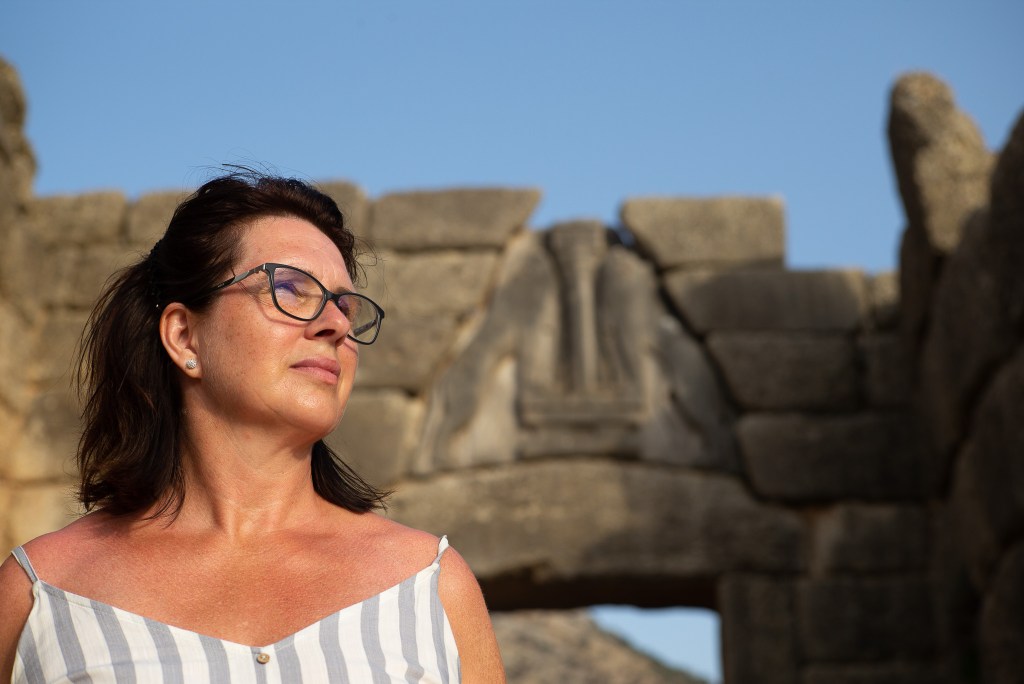
The Lion’s Gate is the main gate of the ancient city of Mycenae and is located in the northwest of the fortified complex. It leads to the so-called great ramp, which continues up through the city to the palace (Megaron).
The Lion Gate dates back to the middle of the 13th century B.C. It received its name because of the relief with which the relief triangle located above the gate was decorated. It shows two lions facing each other and a column between them. The lion relief is the oldest monumental sculpture in Europe.
Passing through it, I had to think of how many times the legendary King Agamemnon himself has passed through this very same gate, also when returning triumphantly as victor of the Trojan war.

Directly behind the Lions Gate Heinrich Schliemann discovered the circular area with the royal tombs, a ring with a diameter of about 28 m with an entrance in the north. Within the burial circle six shaft graves were found, in which a total of 19 dead – 9 men, 8 women and 2 children – were buried. Since particularly rich grave goods were found in the graves, it was assumed that these were graves of the ruling family.
Almost two thousand years ago, the antic travel writer Pausanias (118 – 180 AD) stated that within the city of Mycenae were the tombs of Atreus, Cassandra, Agamemnon, Eurymedon, Electra and one for the twins Teledamos and Pelops. More on Agamemnon and Cassandra later, when we visit the Royal Palace.


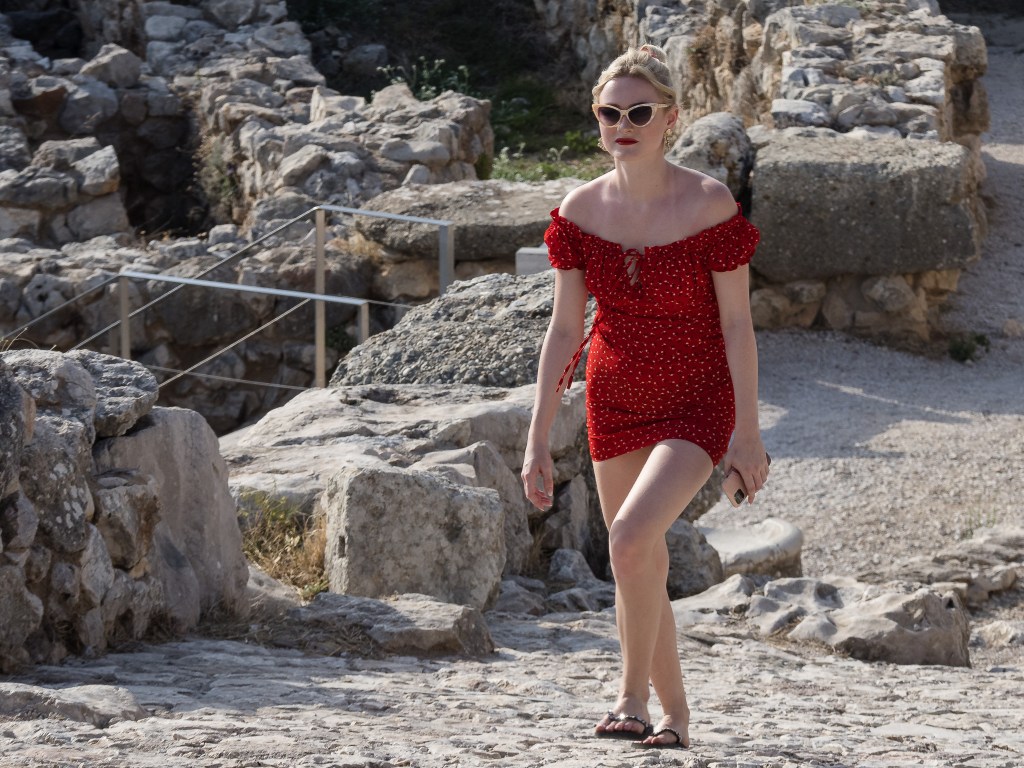
You know that I never pass up on an opportunity to shoot street photography, not even when sightseeing an antic site. How about that young and stylish lady walking up the royal ramp to the palace?

From the Mycenaean palace on the highest point of the upper city there are only sparse remains, because a fire destroyed large parts of the palace; it was also intensively built over in later times. The throne room was a large building in the shape of a megaron. A steep ramp led up to the palace, most of which is preserved.

These are the foundations that remain of the Royal Palace. There was a throne room in the form of a megaron with a central fireplace under a roof opening, around which stood four columns supporting the roof. Next to it there was a throne, and the plastered walls and floors were decorated with frescoes. This room was always entered from a courtyard with a portico, and the courtyard in turn was reached from a terrace by a large staircase. On the right the entrance hall, in the middle the courtyard (Megaron), left the personal (sleeping) quarters, all providing a splendid view onto the Argivian plains below. How amazing to think that the Mycenaean kings ruled and lived in exact those rooms.
Maybe the one or the other of you know the antic sagas from Homer, author of the Iliad and the Odyssey, the two epic poems that are the foundational works of ancient Greek literature and our window into the stories of the lives of the antic heroes like Agamemnon.
The Iliad is set during the Trojan War, the ten-year siege of the city of Troy by a coalition of Mycenaean Greek kingdoms led by Agamemnon (played by Brian Cox in the movie “Troy”).
The mythical occasion of the Trojan War was the abduction of his brother Menelaus (king of Sparta) wife, the beautiful Helen, to Troy by Paris, prince of Troy (Orlando Bloom in the movie). After the gathering of the army and the fleet, they could not yet set out, because goddess Artemis sent headwinds after Agamemnon had killed one of her sacred hinds in Aulis. To appease the winds, the seer Kalchas advised him to sacrifice his daughter Iphigenia to the goddess. At the last moment, however, Artemis took pity on him, placed a hind on the altar instead, and carried Iphigenia off to Tauris.
Ultimately, the Greek conquered Troy (by means of the Trojan horse). Shortly thereafter, Agamemnon returns to Mycenae together with the Trojan seeress Cassandra. It was not a happy return. The hero of Troy is stabbed to death by his wife Clytemnestra (who during the 10 year absence of her husband acquired a lover) in the bath as revenge for the attempted sacrifice of their daughter. According to a widespread version of the saga, Cassandra is also murdered at the same time; according to another, Clytemnestra spares Cassandra. Because of the murder of his father, Agamemnon’s son Orestes will kill his mother years later. For sure those were wild times in ancient Greece.
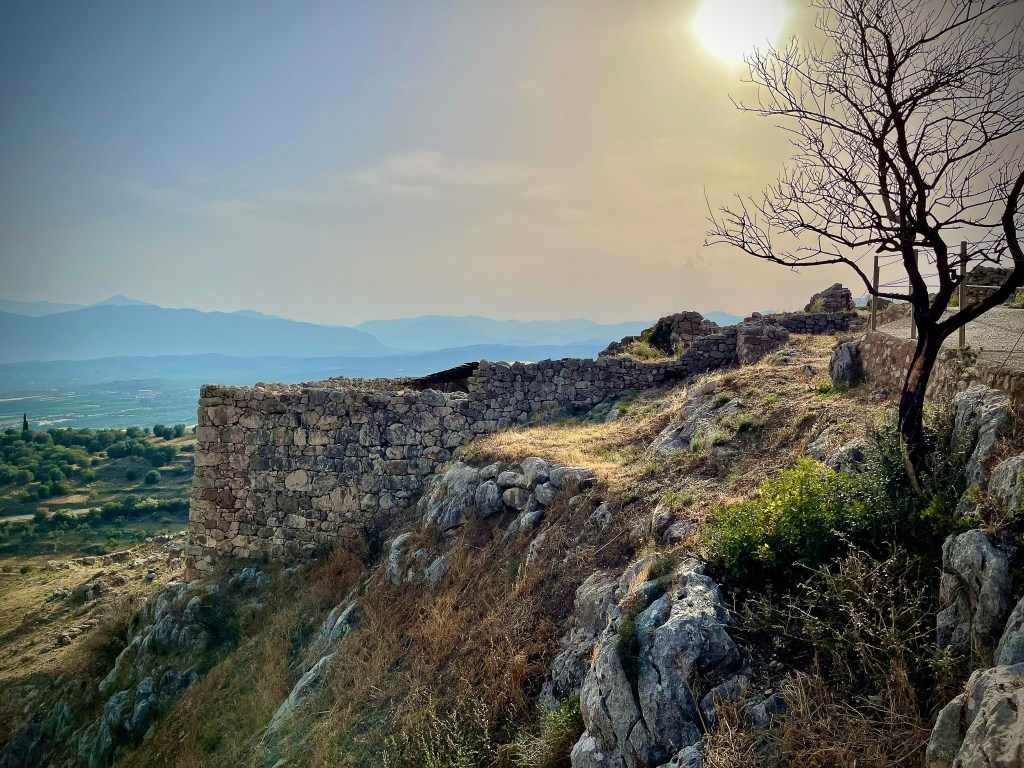

From the palace we ventured through the remains of the upper city of Mycenae, looking down to the olive groves below.

The Significant Other, always adventurous, had to climb down to look into the ancient cistern within the walls of the citadel.
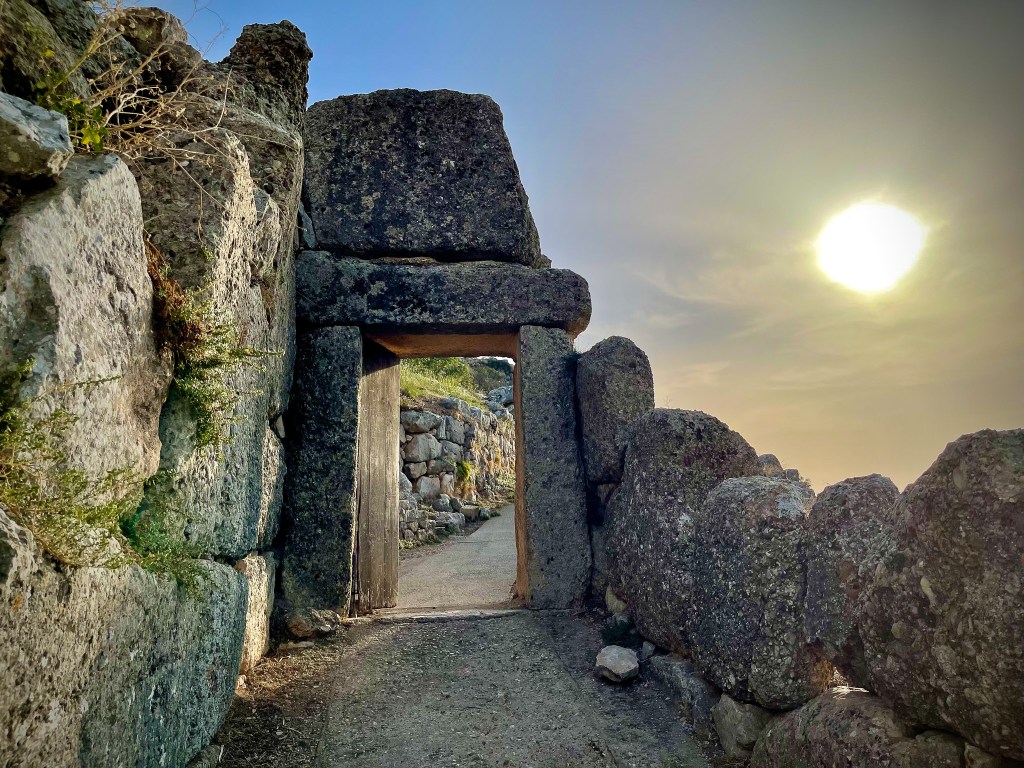
Near the East Annex of the Acropolis is the second entrance to the citadel of Mycenae – the smaller North Gate. The North Gate was built at the same time as the Lion Gate, around 1250 BC, its architecture is also similar. The entrance was also framed by four gigantic stone blocks, is 2.30 meters high and 1.40 meters wide, and was once closed with double wooden doors.

At the end of the visit we returned via the formidable ceremonial ramp to the palace. Once more it was fascinating to think that the very same stones were used by the ancient kings and their visitors when entering or leaving the royal citadel around 3500 years ago.

With closing of the gates at 8pm we also left this place of ancient legends and history with a last view of the Acropolis of Mycenae. I hope you like this tour of this legendary place and its history.
The photographs were taken with the Olympus OM-D E-M1X with the mZuiko 12-100 F/4, the Leica M (240) with the Summicron 35mm F/2 and the Summicrom 50mm F/2, and the iPhone 12 Pro Max. Postprocessing in Lightroom Classic
I hope you liked the second of my “Greece Explored” posts. Stay tuned for more.
Have a great Tuesday
Marcus
Namibia Explored – Elephants of Etosha
From a new follower……
Love the light you’ve captured with your camera. Wonderful detail and a very interesting post.
Thank you very much for your kind words, Vicki, they are highly appreciated! And even more thanks for following! Marcus
Hi Marcus,
It’s been a while, but I am finally back online and it is great to catch up on some of your posts. I love Greek history, it’s incredibly fascinating.
I now have a new blog kicking off, so I look forward to keeping up to date with your adventures.
Fantastic fotos and interesting explanations. Well done!
This was one of our favorite places to see in Greece, and, in some ways, I think our guide was a bit put out with how much time we wanted to spend here. But, as you’ve shown, there is soooo much to see and think about while you’re there. Thanks for beautiful photos, as always, but also for jogging our memory of a very interesting place.
Your SO must be very understanding to let you spend so much time blogging while on your vacation. Thank her for us all, and thanks for letting us join you.
Yeah, she exercised extraordinary patience with me 😉 so true! I pass it on 🙂 ! Thanks for pointing it out, Allan, so much appreciated!! Marcus
Very interesting post. I have never read about this before. In many ways, both Greek and Roman civilizations surprise us with all the finds. Beautiful pictures, as always.
Thanks for reading, Arv, glad you liked it! I always love discover new things by reading other’s blogs. Have a great week! Marcus
That’s the whole idea of getting updated and not missing places.
Beautiful photos to inspire a visit one day Marcus!
Thanks for reading and commenting, Marion, so much appreciated! If you haven’t been down there, go asap, so beautiful and interesting! You’ll love it! Marcus
Wow. What a post, filled with history, beautiful photography and wonderful narrative. Already read it once, have it bookmarked for further times. Thanks, Marcus!
Thanks for your wonderful words, so much appreciated! Have a great week! Marcus
Thank you very much for sharing Marcus.
You are welcome, Jim, thanks so much for taking the time to read! Marcus
A great tour indeed, Marcus.
Thanks for letting us share in your vacation.
And thanks to you for reading, so much appreciated! Have a great week! Marcus
Hi Marcus, this is an amazing post including all the history. I have been many times in Greece, since it’s so close to my home country of Germany back than, never been to Mycenae. Truly enjoyed your post, thank you for sharing.
Thanks so much for your kind words, Cornelia, highly appreciated! Glad you liked the post. Should you ever go back to Greece make sure to put Mycenae on your list! Marcus
Thanks for sharing the beautiful pics & fascinating account of your visit to incredible Mycenae.
Thank you very much for your kind words, I’m glad you liked the post! Have a great week! Marcus
Wonderful photography of your visit to this amazing archeological site! The history, artifacts, structural craftsmanship and scale is very impressive. Thank you for sharing!
Thanks for taking the time to read and for your kind words, Phil, much appreciated! Marcus
Oh, and I meant to say, thanks for the Virtual Tour, Marcus!
Those Ancient Greeks built some AMAZING structures. Sheer size, craftsmanship, building skills…..
Glad you liked the post, Sue, thanks so much for reading! Marcus
😊
So many amazing and beautiful photos, Marcus! It’s so amazing that these people built these structures without modern technology. Thank you for this wonderful tour!
Thanks for taking the rime to read, John! But you are so right…it is mind-blowing walking through this. Still there after 3500 years.
That’s Quality Construction!